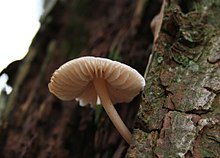| This article includes a list of general references, but it lacks sufficient corresponding inline citations. Please help to improve this article by introducing more precise citations. (April 2013) (Learn how and when to remove this message) |
Osmotrophy is a feeding mechanism involving the movement of dissolved organic compounds by osmosis. Organisms that use osmotrophy are called osmotrophs. Osmotrophy is used by diverse groups of organisms. Organisms that use osmotrophy include microorganisms like bacteria, many species of protists and most fungi. Invertebrate animal groups like molluscs, sponges, corals, brachiopods and echinoderms may use osmotrophic feeding as a supplemental food source.
Process
Osmotrophy, as a means of gathering nutrients in microscopic organisms, relies on the cellular surface area to ensure that proper diffusion of nutrients occurs in the cell. In other words, an osmotroph is an organism that has their "stomach" outside of their body. Some osmotrophs may have an internal digestive system, while still using osmosis as a way to gain supplemental nutrients. With bigger organisms, the surface-area-per-volume ratio drops and osmotrophy becomes insufficient to meet nutrient demands. Larger, macroscopic organisms that rely on osmotrophy, compensate with a very flat, thin body. A tapeworm is an example of such an adaptation.
Fungi

Fungi are the biggest osmotrophic specialist since they are major degraders in all ecosystems. For organisms like fungi, osmotrophy facilitates the decomposition process. This is a result of the osmotrophy resulting in metabolites that continue growth.
Mixotrophs
Some mixotrophic microorganisms use osmotrophy to acquire some of their energy.
See also
References
- ^ Richards TA, Talbot NJ (October 2018). "Osmotrophy". Current Biology. 28 (20): R1179 – R1180. doi:10.1016/j.cub.2018.07.069. PMID 30352181.
- Laflamme M, Xiao S, Kowalewski M (August 2009). "From the Cover: Osmotrophy in modular Ediacara organisms". Proceedings of the National Academy of Sciences of the United States of America. 106 (34): 14438–43. Bibcode:2009PNAS..10614438L. doi:10.1073/pnas.0904836106. PMC 2732876. PMID 19706530.
Further reading
- Jumars PA (2005). "Foraging Theory for Osmotrophs".
{{cite journal}}: Cite journal requires|journal=(help) - Jumars PA, Deming JW, Hill PH, Karp-Boss L, Yager PL, Dade WB (1993). "Physical constraints on marine osmotrophy in an optimal foraging context". Marine Microbial Food Webs. 7 (2): 121–159.
- McMenamin M (1993). "Osmotrophy in fossil protoctists and early animals". Invertebr. Repro. Develop. 23 (2–3): 165–166. doi:10.1080/07924259.1993.9672308.
- Duvert M, Gourdoux L, Moreau R (2000). "Cytochemical And Physiological Studies Of The Energetic Metabolism And Osmotrophy In Sagitta Friderici (Chaetognath)". Journal of the Marine Biological Association of the United Kingdom. 80:5 (5): 885–890. doi:10.1017/s0025315400002861. S2CID 86475776.
This ecology-related article is a stub. You can help Misplaced Pages by expanding it. |